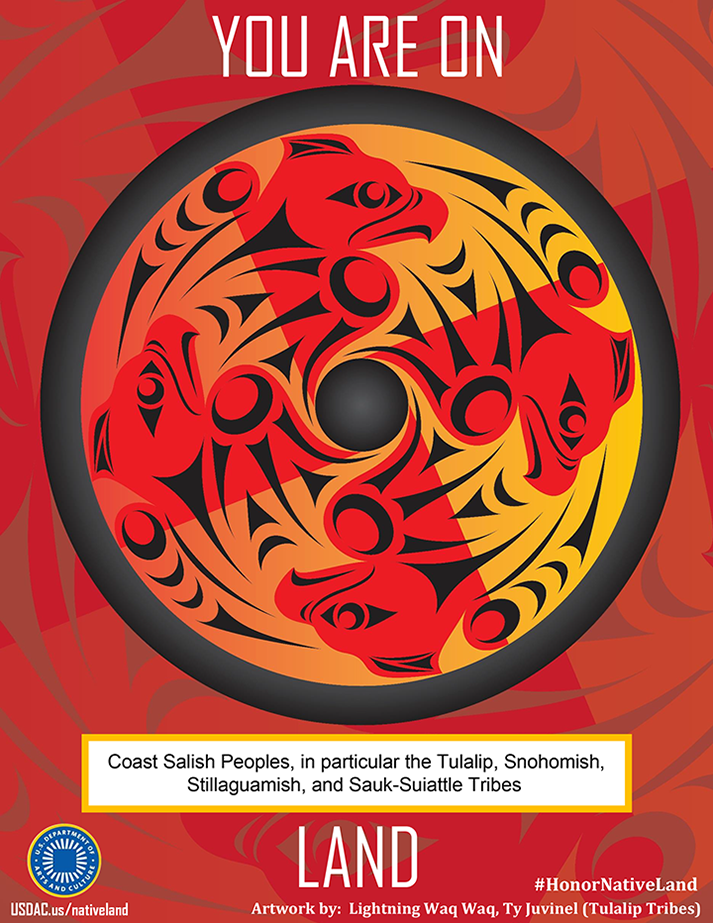

Acknowledgement
We acknowledge that we occupy the ancestral lands of the Coast Salish Peoples, in particular the Tulalip, Snohomish, Stillaguamish, and Sauk-Suiattle Tribes. We see you, respect your right to sovereignty and self-determination, and are committed to being better listeners, learners, and in lifting indigenous voices.
Tribes of Snohomish County
Coast Salish is a group of ethnically and linguistically related Indigenous peoples of the Pacific Northwest Coast, living in British Columbia, Canada and Washington and Oregon. The Coast Salish are a large, loose grouping of many tribes with numerous distinct cultures and languages. Coast Salish territory spans from the northern limit of the Salish Sea (a.k.a. Strait of Georgia) on the inside of Vancouver Island and covers most of southern Vancouver Island, all of the Lower Mainland and most of Puget Sound and the Olympic Peninsula (except for territories of now-extinct Chemakum people).
Within Coast Salish Peoples
- Tulalip Tribes of Washington is a tribe of Duwamish, Snohomish, Snoqualmie, Skagit, Suiattle, Samish, and Stillaguamish people. They are South and Central Coast Salish peoples of indigenous peoples of the Pacific Northwest Coast. Read More >>
- Snohomish Tribe of Indians are from the mouth of the Snohomish River, a Puget Sound tributary north of today's Marysville, on the southern tip of Camano Island, on Whidbey Island opposite today's city of Mukilteo, and along the Snohomish River as far east as today's town of Monroe. Read More >>
- Stillaguamish Tribe of Indians is composed of descendants of the Stoluck-wa-mish River Tribe, who lived on the Stillaguamish River and camped along its tributaries. Tribal headquarters are located in Arlington, Washington. Read More >>
- Sauk-Suiattle Indian Tribe lived along the banks of the Sauk, Suiattle, Cascade, Stillaguamish, and Skagit rivers, in the area known as Sauk Prairie at the foot of Whitehorse Mountain in the North Cascade Range. Tribal headquarters are located in Darrington, Washington. Read More >>
In Snohomish County, only three tribes have been federally recognized: the Sauk-Suiattle Tribe, the Stillaguamish Tribe, and the Tulalip Tribes. Read more on the Snohomish County website.
Learn more about federal recognition.
Identify the Indigenous Lands You're On
Visit the Native Land map, type in an address, and the site will show you many of the tribes that are indigenous to the nearby land.
Learning and Unlearning: Recommended Resources
- The second Monday in October is Indigenous Peoples’ Day. It is a celebration of Native American peoples’ history and cultures and began as an intentional effort to reject the federal holiday of Columbus Day, replacing that false narrative of discovery with the truth of the violent history of colonization, and instead honoring all indigenous peoples. Rethinking How We Celebrate American History.
- November is Native American Heritage Month. Learn more from this resource list from the Burke Museum.
- Explore the Racial Justice Guide to Thanksgiving for Educators and Families from the Center for Racial Justice in Education.
Questions or Comments?
The history of native peoples in the United States is long and complex. The information on this page is by no means comprehensive but is our first step in being a better neighbor to native communities.
We welcome conversation, additions, and/or corrections to the content on this page. Please contact us at info@uwsc.org with questions or comments. Download the poster above or customize it.
